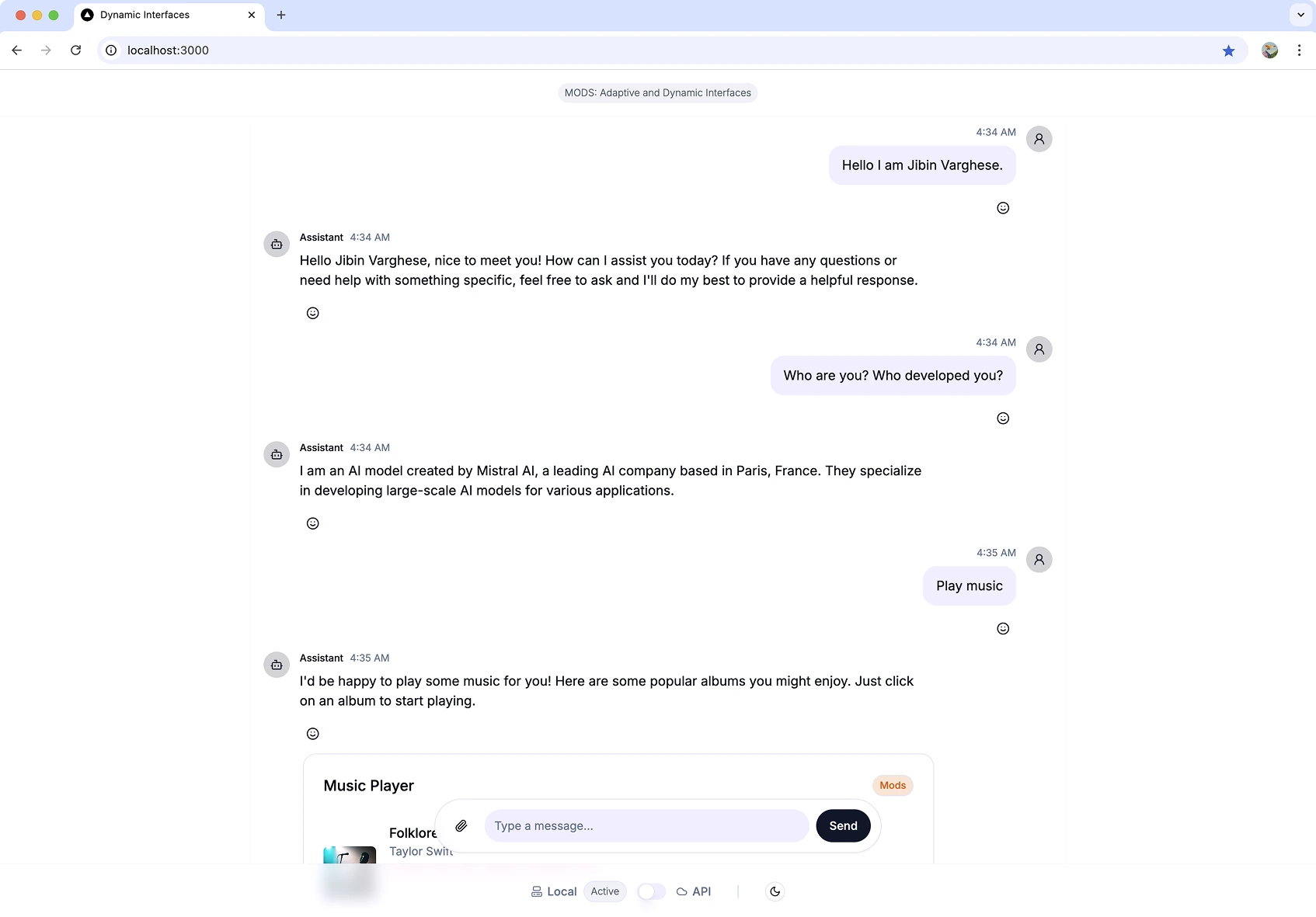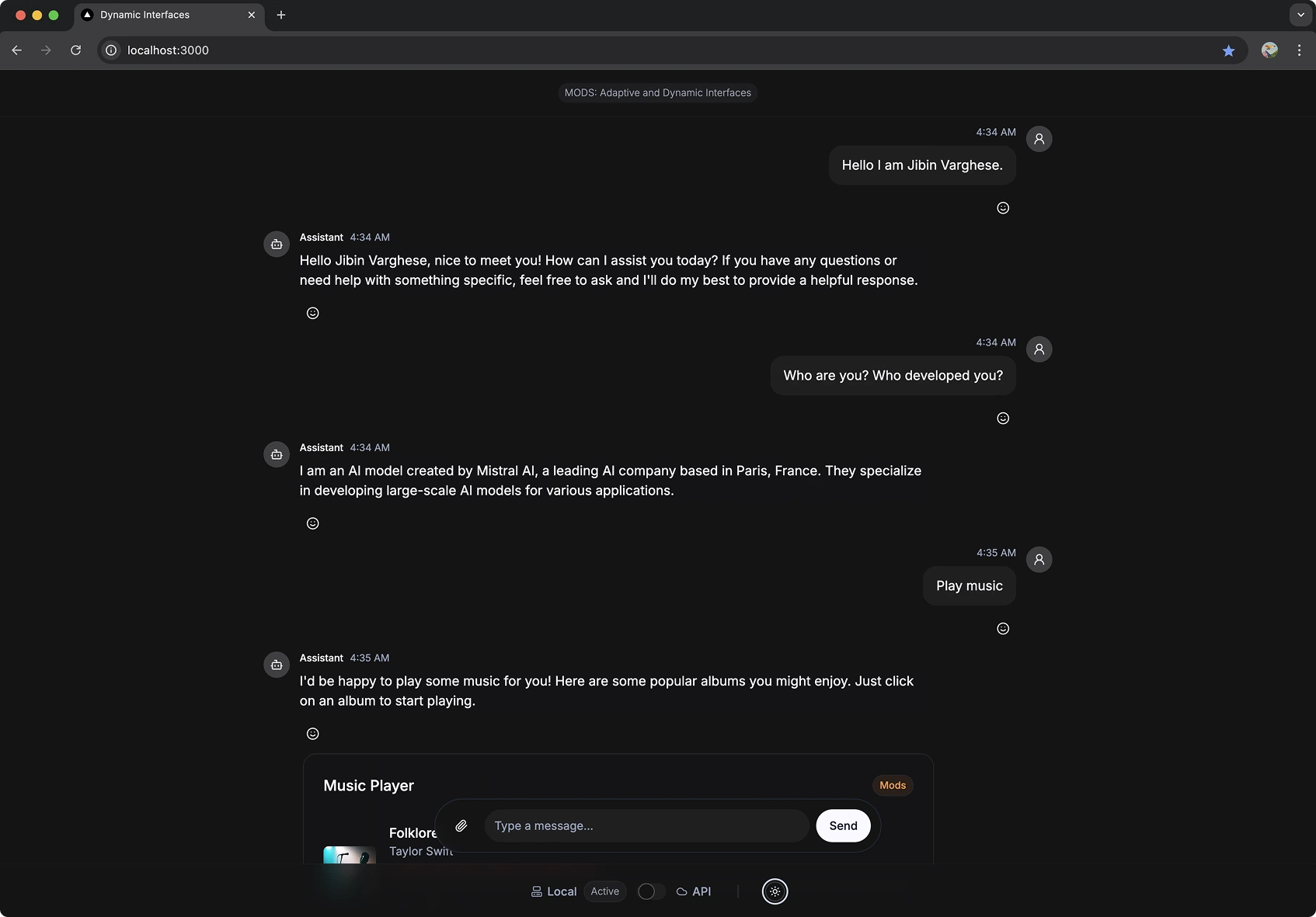I built my own AI playground and here is my experience. Over the weekend, 36hrs straight, I pursued an idea that had been on my mind—combining the “vibe coding” with traditional programming from my CS background.
This application is a modern chat interface with dynamic component rendering that provides interactive experiences based on user queries. It intelligently detects different intents in user messages and responds with appropriate UI components and information.
1. Created my own Webapp: AI playground to delve into more interactive and context-aware
language model
experiences, completely build on free open-source tools.
2. Developed dynamic components, to enhance LLM responses, making them more engaging,
interactive and responsive to context. (Dynamic Charts, Music/Movie player, Summary, Booking
Forms etc.)
Using Mistral 7B local model - response quality may vary compared to latest cloud models, with 85-90% accuracy.
Intelligent Chat Interface
- Real-time messaging with assistant responses
- Message reactions and emoji support
- Clean, modern UI with proper conversation threading
Intent Detection System
- Automatically detects different user intents
- Topic information requests
- Cab booking requests
- Movie recommendations/bookings
- Music player controls
Dynamic and Intelligent Components

Dynamic Component Rendering
- Renders appropriate UI components based on detected intent
- Components appear inline within the conversation
- Smooth transitions between different component types
Topic Summary System
- Intelligent extraction of key information from LLM responses
- Concise summary generation using NLP techniques
- Key point identification and categorization
- Data visualization for relevant statistics
Frontend Architecture
- React with Next.js framework for server-side rendering
- Functional components with React Hooks for state management
- TypeScript for type safety
- Tailwind CSS for styling with a responsive design
Backend Architecture
- Next.js API routes for handling requests
- Python backend server for LLM processing
- REST API communication between frontend and backend
Key Components
- ChatInterface: Main container for the entire chat application
- DynamicComponent: Hub for rendering specialized components
- TopicSummary: Displays concise information about requested topics
- Natural Language Processing Utilities: Intent detection and entity extraction

 React
React
 Tailwind CSS
Tailwind CSS
 Mistral AI
Mistral AI
 Vercel AI SDK
Vercel AI SDK
- User sends a message via the chat interface
- Message is analyzed for intent (topic interest, cab booking, etc.)
- If topic interest is detected:
- 1. The message is sent to the LLM backend
- 2. LLM generates a detailed response
- 3. Response is parsed to extract key information
- 4. A concise summary is generated
- 5. Key points are identified and categorized
- 6. Response and summary card are displayed to the user
- For other intents, appropriate components are rendered

Transforming conversations into experiences by blending intelligence with dynamic, visual components.
- As Mistral AI is a local model and text based model, it is not as accurate as cloud models
- New LLM models can produce code, JSON, and other structured outputs, therefore the rendering is better
- API integration is required for direct flows
- 1. Tasks that took months for me can now be accomplished in days, thanks to AI's capabilities.
- 2. Breaking down projects into smaller modules and integrating them later proves effective helped me divide and conquer complex integrations.
- 3. AI served as a student, teacher, or reviewer. Recognizing when I should assign which role become part of my approach.
- 4. AI not only improved my base algorithms but also introduced innovative ideas I hadn't considered.
- 5. Developing anything new with existing context created consistent modules fater and reduces overall effort.
- 6. Understanding system design before developement helped me to be very intentful for each changes.
- 7. Git help me with version control, saved redo and undos.
Web app build with modern interaction
- More sophisticated intent detection using ML techniques
- Additional dynamic component types for different user needs
- Advanced data visualization for complex topics
- Voice input and output capabilities
- Integration with external APIs for real-time data
- Coming soon...
AI SDK
is an open-source SDK by Vercel that leverages AI to generate UI components from natural language descriptions. It provides real-time previews and allows developers to rapidly prototype and iterate on component designs.
Mistral AI 7B Local Model
is a 7 billion parameter open-source large language model that offers strong performance for code generation and natural language tasks, with around 85-90% accuracy compared to larger commercial models. It runs locally and excels at understanding context and generating high-quality code completions while maintaining reasonable resource requirements.
React
React is a JavaScript library for building user interfaces with reusable components and efficient DOM updates through its virtual DOM implementation. It enables creating dynamic and interactive web applications with a component-based architecture.
Will share more notes soon on agents, design and workflows..


